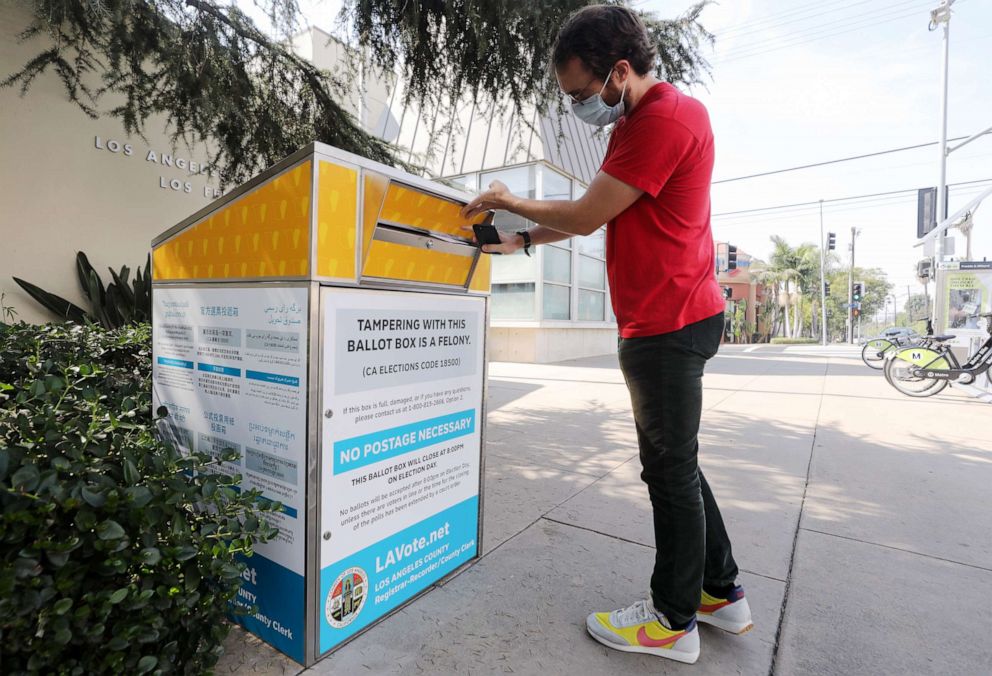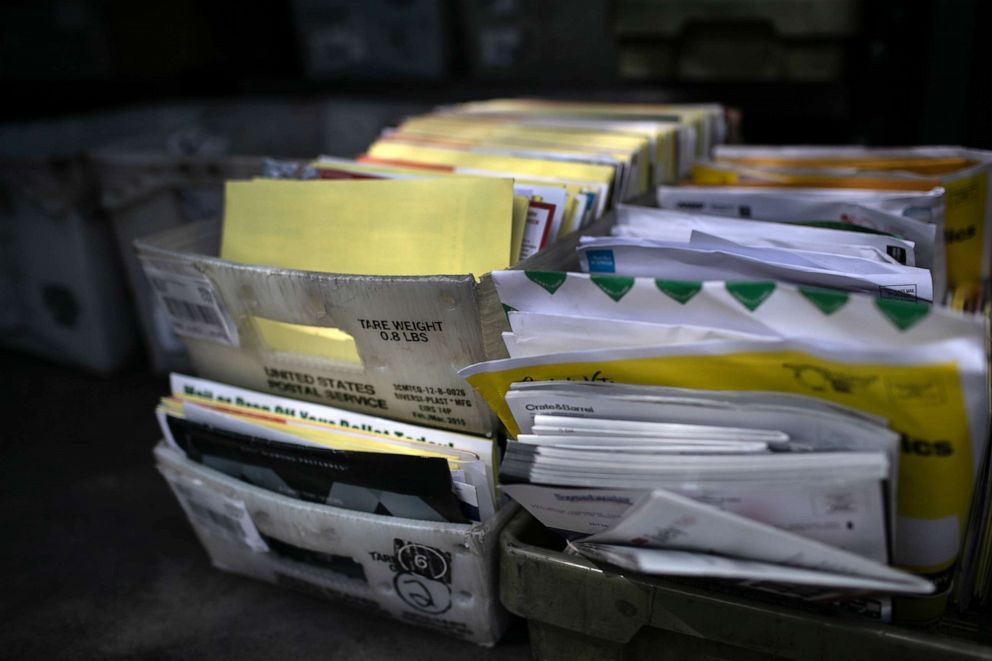Election 2020: How to fill out your mail ballot correctly and avoid having it rejected
With states across the country reporting record numbers of absentee and mail-in ballots expected this year amid the coronavirus pandemic, election officials and experts say voters should take extra care before mailing in or dropping off their ballots.
Some 550,000 ballots were rejected in this year's primaries, more than the 2016 general election, according to an analysis by NPR. That included more than 23,000 ballots in Wisconsin, which were late or filled out incorrectly, more than the margin of President Trump's victory there in 2016.
Most commonly, as was the case in Wisconsin, ballots were rejected because they were late or signatures didn't match and first-time voters and people of color were more likely to have ballots rejected, NPR reported.
Here's what to know about the system and how to try to navigate it in this unique election year:

How mail-in voting is used across the country
A handful of states, including Hawaii, Oregon and Utah, have all mail-in voting. Dozens of others allow no-excuse absentee voting and the rest require an excuse.
Five states, Indiana, Louisiana, Mississippi, Tennessee and Texas, require an excuse beyond COVID-19 to request an absentee ballot. Nine states and the District of Columbia are mailing ballots to all active registered voters. In Montana, most counties are also mailing ballots.
Universal tips, postage requirements
Rules for absentee ballot differ slightly across states and jurisdictions, but some rules apply to all voters.
Those who apply for an absentee ballot should check their voter registration status online and ensure their information is accurate. Mail-in voters should also check their state and county’s deadline for their ballot and the methods to deliver the ballot, according to election offices.
At least 17 states and the District of Columbia provide paid postage for mail voting, according to the National Conference of State Legislatures.
Election offices across the country recommend that voters who have to pay for their own postage use two stamps to ensure proper postage. Many election offices have web-based portals to track ballots that are submitted to ensure that they arrive at their destination and are either accepted or rejected.
Most states require that the ballots be postmarked by Election Day, Nov. 3, and some accept ballots that are delivered in-person to election offices. More information and links to specific election office sites is available at vote.org.
For certain states, there are extra rules in place that voters need to follow to have their ballot properly validated.
Here’s a look at some key potential battleground states, where recent polling margins are slim and a smaller number of votes could decide election:
Arizona
Any registered voter in Arizona is eligible to vote by mail in this year's election.
Voters can send their completed ballots by mail or drop them off directly at their county's election office. Absentee ballots must be received at election offices by 7 p.m. Election Day, Nov. 3.

First-time voters who didn't provide a photo ID with their registration will have to send a photocopy of their ID with their ballot, according to election officials.
Voters in Arizona who are voting by mail can track their ballots online. In Maricopa County, which includes Phoenix, voters can sign up for text updates on the county's website.
Pennsylvania
For the first time, every eligible voter in Pennsylvania is eligible to cast a mail-in ballot.
Mailed-in ballots must be placed in a secrecy sleeve and then in the return envelope. Failure to place those ballots in a secrecy envelope could result in what is known as a "naked ballot," which election experts warn could invalidate numerous ballots.
In September, the Pennsylvania Supreme Court ruled "naked ballots" should be thrown out and not counted. In the wake of that decision, the Pennsylvania Secretary of State's office and election officials across the state have issued several reminders to voters to use the secrecy envelope when casting ballots by mail.
Ballots must be postmarked by Election Day and received within three days after Nov. 3. Voters can also drop off their ballots to election offices and official ballot drop off boxes located throughout the state.
The state has an online tracking tool for mail-in ballots.
Michigan
Voters are instructed to postmark their ballot no later than Nov. 2, and those ballots must be received no later than Tuesday, Nov. 17, according to the state's election law.
Those who choose to hand in their ballot directly to their county board of election office must do so no later than 9 p.m. on Election Day, Nov. 3.
A Michigan voter must place their ballot in a secrecy sleeve and then place that sleeve in the return envelope before putting it in the mail.
If a secrecy envelope isn't provided, voters are instructed to "refold the ballot to conceal your votes," according to Michigan's election law.
The law doesn't authorize township clerks "to remove absent voter ballots from the absent voter ballot secrecy envelopes," until counting gets underway.
"If an opened absent voter ballot return envelope contains an absent voter ballot that is not contained in an absent voter ballot secrecy envelope, the city or township clerk or his or her designee, shall immediately insert that absent voter ballot into an absent voter ballot secrecy envelope," the law said.
The voter must also sign the return envelope before mailing it out.
The Michigan Department of State has a site where voters can track the status of their ballot. Election clerks are also authorized to alert a voter if their ballot is rejected due to a signature issue.
Ohio
Voters in Ohio must place their ballots in the provided secrecy sleeves and then in the return envelope before mailing them to a county election office.

Ballots must be postmarked no later than Nov. 2 but have up until Nov. 13 to be received, according to the state's election rules. Voters can also hand their ballot directly to an election office by Election Day, Nov. 3.
The Ohio Secretary of State launched a website where voters can track their ballot.
Wisconsin
Wisconsin voters who choose to vote via an absentee or mail-in ballot must include a copy of a valid photo ID.
Acceptable forms of ID include a Wisconsin driver's license or identification card, a military ID card issued by a U.S. uniformed service, a U.S. passport or an identification card issued by a federally recognized Indian tribe in Wisconsin.
A "photo identification card issued by a Wisconsin accredited university, college or technical college that contains date of issuance, signature of student, and an expiration date no later than two years after date of issuance," is also accepted, according to election officials.
Voters must also have a witness, which the Wisconsin Election Commission deems any U.S. citizen over 18, sign and provide their address on the ballot. Wisconsin voters can bring their ballots to their county clerk in person up to two weeks before the election.
"If you apply for an absentee ballot in your municipal clerk's office, or another designated location for in-person absentee voting, you will vote your ballot immediately in the clerk's office, seal your ballot in the proper envelope, and return it to a member of the clerk's staff," the commission wrote on its site.
Early in-person absentee voting dates and times vary by county, and Wisconsin voters are encouraged to contact their municipal clerk for more information.
Ballots must be received by election offices no later than 8 p.m. Election Day, Nov. 3. The commission recommends that voters who choose to mail their ballots do so until Oct. 27 at the latest to ensure it arrives at the county office in time.
The state also has a site to track the status of absentee ballots.
Florida
Florida's mail-in ballot rules differ by county, particularly when it comes to postage.
Several counties, such as Orange and Osceola, offer prepaid envelopes, while others, like Seminole and Flager, require the voter to pay for their own postage.
First-time Florida voters who did not provide a photo ID when they registered must include a photocopy of a photo ID.

Counties can begin officially counting mail-in ballots 22 days before Election Day, Nov. 3. All ballots must be received by 7 p.m. Election Day.
A supervisor of elections is required “as it is practical" to inform a voter if their signature is missing or doesn't match the one on record, according to the Florida Division of Elections.
Once a voter is informed about the error, that voter can fill out a “vote-by-mail ballot cure” affidavit to correct the error, according to the office. Voters will have to send a photocopy of their identification with their vote by mail ballot cure affidavit, according to election officials.
"The deadline to submit the form and the ID is no later than 5 p.m. on the 2nd day after an election," the Florida Division of Elections said on its website.
ABC News' Kendall Karson, Quinn Scanlan, Alisa Wiersema and Will McDuffie contributed to this report.





